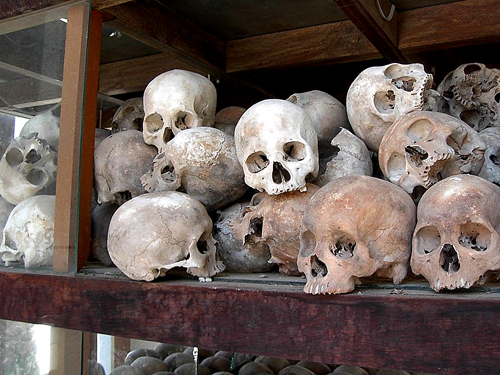In 1969, President Richard Nixon ordered the clandestine bombing of suspected Viet Cong supply routes in Cambodia. That campaign of U.S. aggression continued until 1973, killing an estimated 100,000 Cambodians, and fostered the overthrow of Lon Nol’s pro-American government by Pol Pot and the Khmer Rouge.
Memories of the killing fields
In 1969, President Richard Nixon ordered the clandestine bombing of suspected Viet Cong supply routes in Cambodia. That campaign of U.S. aggression continued until 1973, killing an estimated 100,000 Cambodians, and fostered the overthrow of Lon Nol’s pro-American government by Pol Pot and the Khmer Rouge.

The Khmer Rouge’s genocide was fueled by their vision of a pre-industrial, agrarian, communist Cambodia. Although scholars debate the exact number, 1.7 million Cambodians—about 21 percent of the population—are estimatedby Yale’s Cambodian Genocide Program to have died either at the hands of another (often by crude and primitive weapons), of disease, hunger or overwork.
The grand narrative of this upheaval, which refugee Cambodian journalist Dith Pran dubbed “The Killing Fields,” is still debated by scholars. Yet there exists in our very own city a community of Cambodian refugees and their families with stories of their own.
These stories are the focus of a 2009 documentary, produced by the Cambodian American Community of Oregon in collaboration with PSU, titled The OH Project. The film will be shown as part of the Genocide and Intergenerational Trauma film and discussion event, held by the Portland Center for Public Humanities at Portland State.
The “OH” in the film’s title stands for oral history. The film represents an oral testimony of local survivors, many of whose stories are being told for the first time on camera. The participants were interviewed by the younger generation of Cambodian Americans, those born on this soil and largely unaware of their elders’ harrowing experiences.
Their parents and grandparents, notably younger than one expects genocide survivors to be, often struggle to maintain their composure as they relate personal narratives of broken families, forced relocation, torture and mass murder. Many still suffer from post-traumatic stress disorder, and the strain of recounting their experiences often leaves them in tears.
The second- and third-generation interviewers sometimes express that they “did not know,” of their parents’ struggles, prompting the viewer to wonder how the survivors were able to keep such stories hidden for so long.
There is a certain ignorance, a silence that surrounds the Cambodian genocide that only partly results from a paucity of information.
According to Patricia Schechter, a PSU history professor who helped produce the film, the question at the core of the speakers’ dilemma is: “How could Cambodians do this to each other?” It’s not entirely clear that the film supplies an answer, its purpose being more inquisitive than pedagogical.
The film employs a wealth of blue-toned archival footage and stills with narration toward resolving the viewer’s historical obliviousness. But the focus is on the individuals affected by a grand geopolitical narrative of tactical apathy and ideological perversion. Viewers are advised to equip themselves with contextual knowledge before the screening.
PSU Professor and Director of the Center for the Humanities Marie Lo pointed out that almost everyone knows about the Holocaust, while relatively few people have even heard of the Cambodian genocide.
“One thing about the Cambodian genocide is that it has not yet become a conventionalized or ‘iconic’ historical episode in ‘the West,’ structured with a familiar cast of characters and with a recognizable ending, at least for American audiences,” Schechter explained. “It is a story, for example, with U.S. implications, and one in which the U.S. is not the hero or victor, as in World War II.”
However, Schechter also points out that these narratives are not about America and Americans. The personal nature of these stories and the oral format give the survivors ownership of, and agency over, the narrative of the Cambodian genocide.
Lo is also one of the coordinators of the Genocide and Intergenerational Trauma event that will present this film as a prelude to a panel discussion by members of the Cambodian American Community of Oregon.
The panel will consist of survivors of the Cambodian genocide telling their stories live to the public. Some of the speakers will have related their stories before, and others will be sharing them for the first time.
This event is a rare opportunity to witness the creation of primary-source historical knowledge. The panel members will present their oral testimony before taking questions from the audience. It will likely be extremely emotional.
The Holocaust and Genocide Study Project was made possible thanks to a grant by Nathan Cogan, an emeritus professor in the PSU English department.
The OH Project’s significance obviously extends beyond academic enrichment. The purpose of studying these historic disturbances “is to remind us all that we’re never fully safe from this kind of violent eruption,” said Marcia Klotz, a PSU professor of genocide studies. “And to remind us that the victims are all around us, and that the effects of this kind of historical atrocity tend to spread like ripples, from generation to generation, from continent to continent.”
Genocide and Intergenerational Trauma: film and discussion
Sunday, May 8 7–9 p.m.
Smith Memorial Student Union, room 238
Free and open to the public





